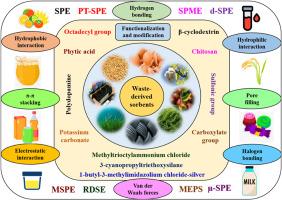Waste-derived sorbents in analytical extraction processes: A review
IF 12
1区 化学
Q1 CHEMISTRY, ANALYTICAL
引用次数: 0
Abstract
Alongside the advancement of analytical extraction methods, analytical chemists have focused their efforts on developing sorbents that adhere to the tenets of green analytical chemistry. Waste-derived sorbents (WDSs) are green, low-priced, and abundant materials with distinguished properties such as facile functionalization and modification, as well as good chemical stability and biocompatibility. WDSs enable the adsorption of various organic molecules through mechanisms including hydrophobic interactions, hydrogen bonding, hydrophilic interactions, and π-π stacking. Hence, WDSs and their composite/modified materials not only can overcome the drawbacks of conventional sorbents and provide novel extracting materials but also inspire the improvement of extraction processes. Therefore, the development of WDSs brings new vigor to extraction technology. This article presents recent advances and progress in applying WDSs as sorbents over the period 2020–2025. In this context: (i) WDSs and their properties will be investigated; (ii) different modified/functionalized WDSs will also be discussed; (iii) it will cover the application of WDSs in solid-phase extraction and solid-phase microextraction techniques; (iv) the potential mechanisms for the extraction of diverse analytes from different samples utilizing WDSs will be examined and discussed; and (v) current trends and issues of WDSs as extraction materials will be analyzed, and prospects will be projected. This article aims to offer insights and perspectives that enhance the understanding of these intriguing materials, focusing on their properties and their present and future roles in analyte extraction techniques.

分析萃取过程中废物吸附剂的研究进展
随着分析提取方法的进步,分析化学家们一直致力于开发符合绿色分析化学原则的吸附剂。垃圾吸附剂(WDSs)是一种绿色、廉价、丰富的材料,具有易于功能化和改性、化学稳定性和生物相容性好等特点。wds通过疏水相互作用、氢键作用、亲水性相互作用和π-π堆积等机制吸附各种有机分子。因此,WDSs及其复合/改性材料不仅可以克服传统吸附剂的缺点,提供新的提取材料,而且可以激发提取工艺的改进。因此,wds的发展为萃取技术带来了新的活力。本文介绍了2020-2025年期间wds作为吸附剂的最新进展和进展。在这方面:(i)将调查污水处理机及其性质;(ii)亦会讨论不同的经修改/功能化的污水处理站;(iii)将涵盖水分解物质在固相萃取和固相微萃取技术中的应用;(iv)研究和讨论利用WDSs从不同样品中提取不同分析物的潜在机制;(五)分析水分解材料作为提取材料的当前趋势和问题,并预测其前景。本文旨在提供见解和观点,以增强对这些有趣材料的理解,重点介绍它们的性质及其在分析物提取技术中的现在和未来作用。
本文章由计算机程序翻译,如有差异,请以英文原文为准。
求助全文
约1分钟内获得全文
求助全文
来源期刊

Trends in Analytical Chemistry
化学-分析化学
CiteScore
20.00
自引率
4.60%
发文量
257
审稿时长
3.4 months
期刊介绍:
TrAC publishes succinct and critical overviews of recent advancements in analytical chemistry, designed to assist analytical chemists and other users of analytical techniques. These reviews offer excellent, up-to-date, and timely coverage of various topics within analytical chemistry. Encompassing areas such as analytical instrumentation, biomedical analysis, biomolecular analysis, biosensors, chemical analysis, chemometrics, clinical chemistry, drug discovery, environmental analysis and monitoring, food analysis, forensic science, laboratory automation, materials science, metabolomics, pesticide-residue analysis, pharmaceutical analysis, proteomics, surface science, and water analysis and monitoring, these critical reviews provide comprehensive insights for practitioners in the field.
 求助内容:
求助内容: 应助结果提醒方式:
应助结果提醒方式:


